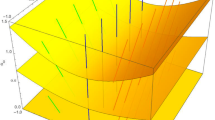Abstract
A new gauge theory of gravity on flat spacetime has recently been developed by Lasenby, Doran, and Gull. Einstein’s principles of equivalence and general relativity are replaced by gauge principles asserting, respectively, local rotation and global displacement gauge invariance. A new unitary formulation of Einstein’s tensor illuminates long-standing problems with energy–momentum conservation in general relativity. Geometric calculus provides many simplifications and fresh insights in theoretical formulation and physical applications of the theory.
Similar content being viewed by others
References
H. Poincaré (1951) Science and Hypothesis Dover New York
C. Doran A. Lasenby (2003) Geometric Algebra for Physicists Cambridge University Press Cambridge
A. Lasenby C. Doran S. Gull (1998) ArticleTitle“Gravity, gauge theories and geometric algebra” Phil. Trans. R. Lond. A 356 487–582
A. Grünbaum (1963) Philosophical Problems of Space and Time Knopf New York
R. Feynman (1995) Feynman Lectures on Gravitation Addison-Wesley Reading
D. Hestenes (2003) ArticleTitle“Oersted Medal Lecture 2002: Reforming the mathematical language of physics” Am. J. Phys. 71 104–121 Occurrence Handle10.1119/1.1522700
D. Hestenes (2003) ArticleTitle“Spacetime physics with geometric algebra” Am. J. Phys. 71 691–704 Occurrence Handle10.1119/1.1571836
D. Hestenes G. Sobczyk (1986) CLIFFORD ALGEBRA to GEOMETRIC CALCULUS, a Unified Language for Mathematics and Physics Kluwer Academic Dordrecht/Boston
Hestenes (1993) “Differential forms in geometric Calculus” F. Brackx R. Delanghe H. Serras (Eds) Clifford Algebras and their Applications in Mathematical Physics Kluwer Academic Dordrecht/Boston 269–285
R. d’Inverno (1992) Introducing Einstein’s Relativity Clarendon Press Oxford
F. Heyl P. Heyde Particlevon der D. Kerlick (1976) ArticleTitle“General relativity with spin and torsion: Foundations adn prospectus” Rev. Mod. Phys. 48 393–416 Occurrence Handle10.1103/RevModPhys.48.393
C. Misner K. Thorne J. Wheeler (1973) Gravitation Freeman San Francisco
D. Hestenes (1991) ArticleTitle“The design of linear algebra and geometry” Acta Appl. Math. 23 65–93 Occurrence Handle10.1007/BF00046920
C. Doran D. Hestenes F. Sommen N. Acker ParticleVan (1993) ArticleTitle“Lie groups as spin groups” J. Math. Phys. 34 3642–3669 Occurrence Handle10.1063/1.530050
Of course, this use of the “overbar notation” is an abuse of our notation for linear operators, but as the operator h̄ is involved, it helps distinguish gauge covariant fields from fields that are not gauge covariant. Caligraphic font is used for the same purpose in Ref. 2.
W. R. Davis (1966) ArticleTitle“The Role of tetrad and flat-metric fields in the framework of the general theory of relativity” Nuovo Cimento 43 2816–2820
J. Earman (1974) ArticleTitle“Covariance, invariance, and the equivalence of frames” Found. Phys. 4 267–289 Occurrence Handle10.1007/BF00712691
S. Gull A. Lasenby C. Doran (1996) “Geometric algebra, spacetime physics and gravitation” O. Lahav E. Terlevich R. Terlevich (Eds) bnGravitational Dynamics Cambridge University Press Cambridge 171–180
P. Havas (1989) “The Early History of the ‘Problem of Motion’ in General Relativity” O. Lahav E. Terlevich R. Terlevich (Eds) Einstein and the History of General Relativity Birkhäuser Boston 234–276
D. Hestenes (1986) ArticleTitle“A spinor approach to gravitaional motion and precession” Int. J. Theo. Phys. 25 589–598 Occurrence Handle10.1007/BF00670473
<www.mrao.cam.ac.uk>.
R. Gautreau, “Light comes inside the Schwarzschild radius,” Am. J. Phys. 63, 431–439 (1995); “Comological Schwarzschild radii and Newtonian gravitational theory,” Am. J. Phys. 64, 1457–1467 (1996); R. Gautreau and J. Cohen, “Gravitational collapse in a single coordinates system,” Am. J. Phys. 63, 991–999 (1995); “Gravitational expansion and the destruction of a black hole,” Am. J. Phys. 65, 198–201 (1997).
E. Taylor J. Wheeler (2004) Exploring Black Holes: Introduction to General Relativity Addison Wesley Reading
D. Hestenes, New Foundations for Classical Mechanics (Kluwer, Dordrecht/Boston, 1986), 2nd edn. (1999).
A. Einstein, “Hamilton’s Principle and the General Theory of Relativity”, in Sitzungsber. D. Preuss. Akad. D. Wiss., 1916. English translation in The Principle of Relativity (Dover, 1923).
Page 46 in Ref.18.
S. Babak L. Grishchuk (1999) ArticleTitle“Energy–momentum tensor for the gravitational field” Phys. Rev. D 61 1–18
D. Hestenes, “Energy–momentum Complex in General Relativity and Gauge Theory Gravity”, to be published. Available at the website: <http://modelingnts.la.asu.edu>.
C. Doran A. Lasenby A. Challinor S. Gull (1988) ArticleTitle“Effects of spin-torsion in gauge theory gravity” J. Math. Phys. 39 3303–3321 Occurrence Handle10.1063/1.532255
Chapter 9: “Foundations of Mechanics” in Ref.30. This chapter was replaced by a chapter on Relativity in the Second Edition. However, it is available at the website: <http://modelingnts.la.asu.edu>
D. Hestenes (1992) ArticleTitle“Modeling Games in the Newtonian World” Am. J. Phys. 60 732–748
S. Hawking, and G. Ellis, The Large Scale Structure of Spacetime (Cambridge, 1973).
Author information
Authors and Affiliations
Corresponding author
Rights and permissions
About this article
Cite this article
Hestenes, D. Gauge Theory Gravity with Geometric Calculus. Found Phys 35, 903–970 (2005). https://doi.org/10.1007/s10701-005-5828-y
Received:
Issue Date:
DOI: https://doi.org/10.1007/s10701-005-5828-y




